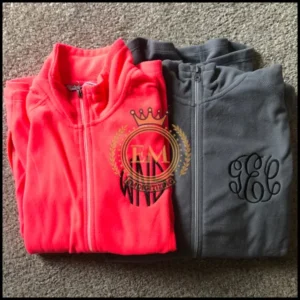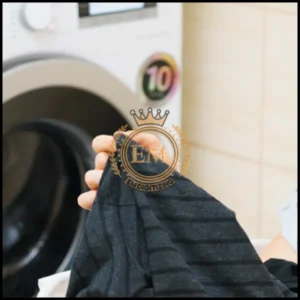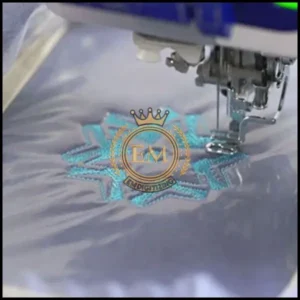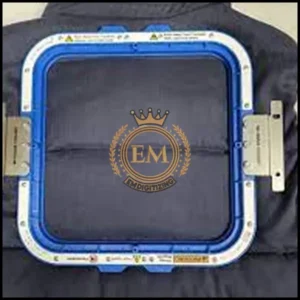Das Sticken auf Fleece ist eine entzückende Möglichkeit, diesen weichen und beliebten Stoff zu personalisieren und zu verschönern. Whether you’;Erstellen Sie ein individuelles Geschenk oder fügen Sie Ihrer Kleidung eine einzigartige Note hinzu, Der Prozess ist sowohl lohnend als auch kreativ.

Vlies, mit seiner plüschigen Textur, Erfordert besondere Überlegungen im Vergleich zu anderen Stoffen. Dieser Leitfaden hilft Ihnen dabei, die Kunst des Stickens am Fleece zu beherrschen, sicherstellen, Jedes Mal klare Entwürfe.
Schritt-für-Schritt-Anleitung zum Sticken auf Fleece
Wählen Sie das richtige Fleece und das richtige Design:
Anfangen vorbei Auswählen des rechten Stoffes und Design zum Sticken auf Fleece:
Auswählen des entsprechenden Vliesgewichts und des entsprechenden Typs:
Now that we’;Ich habe die Grundlagen von Fleece behandelt, it’;s Zeit, um den richtigen Typ und das richtige Gewicht von Fleece für Ihre auszuwählen Stickprojekt. Fleece kommt in verschiedenen Gewichten, reicht von leicht bis Schwergewicht.
Das Gewicht des Vlies wirkt sich auf das Drapieren aus, Wärme, und insgesamt Aussehen Ihres fertigen Stücks. Zum Sticken, it’;s im Allgemeinen empfohlen, mittelgroße Vlies zu verwenden. Dieses Gewicht schlägt ein Gleichgewicht zwischen Dicke und Leichtigkeit der Stickerei ein.

Jedoch, if you’;Gehen Sie für einen leichteren und drapey -Look, Sie können sich für ein leichteres Fleece entscheiden. Andererseits, Wenn Sie ein super gemütliches und warmes fertiges Produkt wünschen, Sie können ein schwereres Fleece entscheiden.
Optimierung von Designs für die Stickerei:
Wenn es um das Entwerfen für Fleece -Stickereien geht, Einfachheit ist der Schlüssel. Die Plüschstruktur von Fleece kann komplizierte Designs durcheinander und weniger definiert erscheinen lassen.
So, it’;S am besten zu Wählen Sie Designs Das haben klare Linien und weniger kleine Details. Mutige und einfache Designs neigen dazu, sich mehr auf Vlies abzuheben und ein saubereres Aussehen zu verleihen.

Zusätzlich, Betrachten Sie die Farbe des Vlies bei der Auswahl Ihres Designs. Dunklere Farben zeigen neigen, um Stickstiele klarer zu zeigen, Während leichtere Farben möglicherweise mutigere Fadenauswahl für das Design erfordern, um zu popieren.
Vorbereitung des Vlies für Stickereien:
Nach Auswahl des Designs und des Stoffes, Bereiten Sie den Stoff für Stickerei vor:
Waschen und Trocknen von Fleece richtig:
Bevor Sie mit dem Nähen beginnen, it’;S wichtig, um Ihrem Fleece -Stoff a zu geben Gute Wäsche. Dies hilft, überschüssige Chemikalien oder Beschichtungen zu entfernen, die den Stickprozess beeinträchtigen könnten.

Befolgen Sie die Pflegeanweisungen in Ihrem Fleece -Stoff, aber im Allgemeinen, Ein sanfter Waschzyklus mit mildem Waschmittel wird empfohlen. Vermeiden Sie die Verwendung von Weichspülern, Da können sie einen Rückstand hinterlassen, der es der Stickerei erschwert, sich richtig zu halten.
Nach dem Waschen, Stellen Sie sicher. Hängen oder legen Sie es flach in die Luft trocken, als übermäßige Wärme kann zu Schrumpfungen oder Schäden am Stoff führen.
Stabilisierung von Vlies für Stickereien:
Die Stabilisierung ist entscheidend beim Sticken auf Fleece. Da ist Fleece ein dehnbarer Stoff, Es neigt dazu, sich während des Stickprozesses zu bewegen und zu dehnen, was zu Puckering und verzerrten Designs führt. Um dies zu verhindern, you’;Ich muss einen Stabilisator verwenden, um das Fleece stabil und straff zu halten.

Eine beliebte Wahl für das Stabilisierung von Fleece ist ein Tränenstabilisator. Diese Art des Stabilisators ist einfach zu bedienen und, wie der Name schon sagt, kann leicht weggerissen werden, sobald die Stickerei abgeschlossen ist. Einfach den Stabilisator zusammen mit dem Fleece zusammenfassen, making sure it’;s fest gesichert.
Einrichten der Stickmaschine:
Jetzt, Es ist Zeit, den Prozess zu starten:
Wählen Sie die richtige Nadel und den richtigen Faden aus:
Wenn es darum geht, auf Fleece zu nähen, Ihre Nadel- und Fadenauswahl kann eine Welt des Unterschieds bewirken.
- Für beste Ergebnisse, Verwenden Sie eine scharfe Nadel, wie eine Größe 75/11 oder 80/12, da es die Fleece -Fasern effizienter durchdringt.
- Was den Thread betrifft, Polyester oder Viskose Stickgarn wird für seine Festigkeit und seine lebendigen Farben empfohlen.
Spannungs- und Reifentechniken einstellen:
Um einen reibungslosen Stickprozess zu gewährleisten, it’;s Essentiell, um die Spannung Ihrer Maschine anzupassen. Fleece kann etwas hartnäckig sein und benötigen möglicherweise leicht lockerer Spannungseinstellungen als üblich. Experiment with your machine’;Spannungseinstellungen, bis Sie den Sweet Spot finden, der saubere und sogar Stiche erzeugt.

Das richtige Reifen ist auch für eine erfolgreiche Vliesstickerei von entscheidender Bedeutung. Stellen Sie sicher, dass das Fleece sicher gerichtet ist, ohne übermäßige Dehnung oder kräuseln. Wenn benötigt, Sie können zusätzliche Clips oder Stifte verwenden, um die Ränder des Stoffes innerhalb des Reifens zu sichern.
Einrichten der Stickmaschine:
Es gibt einige Techniken, die Sie befolgen können, um die besten Ergebnisse zu erzielen:
Auswählen der richtigen Stickereien:
Das Sticken auf Vlies kann aufgrund seiner flauschigen Natur etwas schwierig sein, aber mit dem Richtige Stickereien, Sie können atemberaubende Ergebnisse erzielen. Bei der Auswahl von Designs für Fleece, opt for ones that aren’;t zu kompliziert oder zu viel Dichte haben.
Simple and open designs tend to work best on fleece as they won’;t get lost in the fabric’;S Textur. Erwägen Sie, Entwürfe mit größeren Elementen auszuwählen, um sicherzustellen, dass sie sich gut abheben.
Arbeiten Sie mit Stickmaschineneinstellungen:
Um eine erfolgreiche Stickerei auf Fleece zu erreichen, it’;S wichtig, um Ihre Stickmaschine einzustellen, entsprechend. Wählen Sie zunächst eine Kugelschreibernadel aus, die speziell für dehnbare Stoffe wie Fleece entwickelt wurde.
Durch geringes Verringern der Spannung kann auch das Klopfen des Stoffes verhindern. Zusätzlich, slowing down the machine’;S -Geschwindigkeit kann Ihnen mehr Kontrolle geben und verhindern, dass die Nadel zu aggressiv durch den Stoff schlägt.
Don’;Ich habe Angst, mit verschiedenen Einstellungen zu experimentieren, um die perfekte Kombination für Ihren spezifischen Fleece -Stoff zu finden.
Beenden und Fürsorge für gestickte Vlies:
Sobald Sie den Stickprozess abgeschlossen haben, Lassen Sie uns den letzten Schliff geben:
Stickstiche zuschneiden und reinigen:
Once you’;Ich habe Ihre Stickerei auf dem Fleece abgeschlossen, it’;s unerlässlich, um ihm ein poliertes Finish zu verleihen. Schneiden Sie den überschüssigen Stabilisator vorsichtig von der Rückseite des Stoffes ab, sicherstellen, dass keine Stiche durchschneiden.
Verwenden Sie klein, scharf Stickschere Nehmen Sie sich Zeit, um saubere und präzise Schnitte zu erreichen. Achten auf jeden Sprungstiche und schneiden Sie sie ordentlich, um Ihrer Stickerei einen professionellen Look zu verleihen.
Richtig waschen und aufbewahrt, gesticktes Fleece:
Um die Langlebigkeit Ihres gestickten Vlies zu gewährleisten, it’;von entscheidender Bedeutung, um es richtig zu kümmern. Befolgen Sie immer die Pflegeanweisungen mit dem Fleece -Stoff, aber im Allgemeinen, it’;S am besten, um Vlies in kaltem Wasser und in einem sanften Zyklus zu waschen.
Vermeiden Sie es, raue Reinigungsmittel oder Stoffweichspüler zu verwenden, die die Stickerei beschädigen können. Beim Speichern, Falten Sie das Vlies sorgfältig, um zu vermeiden, die Stickerei zu falten, Und halten Sie es in einem kühlen Fall, Trockener Ort, um feuchtigkeitsbedingte Schäden zu vermeiden.
Abschließende Gedanken:
Erinnern, Das Sticken des Vlies kann seine Herausforderungen haben, Aber mit Übung und einem Gefühl des Abenteuers, you’;Ich kann schöne und gemütliche gestickte Stücke kreieren, die mit Sicherheit beeindrucken werden.
Schnapp dir also deine Stickmaschine, und etwas Fleece -Stoff, Und nähen!
EMdigitalisieren: Stickdigitalisierung und Vektorkunstanbieter:
If you’;Suchen Sie nach höchster Qualität Stickerei digitalisieren, Schauen Sie sich die Emdigitation an. We’;RE -Experten für Stickdigitalisierung und Vektorkunst, Und wir bieten tolle Preise an.
Plus, Wir haben etwas Besonderes 50% Rabatt für neue Kunden! Sprechen Sie mit uns darüber, was Sie brauchen, and we’;Ich gebe dir ein kostenloses Angebot in gerade 5 Protokoll.
Wenn Sie irgendwelche Fragen haben, Unser freundliches Team ist immer bereit zu helfen. Teilen Sie diesen Artikel mit Ihren Freunden, wenn Sie ihn hilfreich finden.
Danke fürs Lesen, und viel Spaß beim Nähen!
Häufig gestellte Fragen:
Beim Sticken auf Fleece, Verwenden Sie einen Stabilisator, um dem Strecken der Strecke entgegenzuwirken, Entscheiden Sie sich für Designs mit offenen Mustern, und ändern Sie Ihre Maschineneinstellungen für einen geringfügig verlängerten Stich.
Das Sticken auf Fleece kann mit den richtigen Methoden unkompliziert sein, einschließlich der Verwendung geeigneter Stabilisierung und der Auswahl des richtigen Designs, um der dehnbaren und dicken Textur aufzunehmen.
The satin stitch works well with fleece due to its excellent coverage and compatibility with the fabric’;S Textur, Aber seien Sie vorsichtig, keine zu dichten Stiche zu verwenden, wie sie zum Klopfen führen könnten.
Zum Sticken von Vlies, eine größere Nadel speziell Größen 75/11 oder 80/12, Es wird empfohlen, seine Dicke effektiv zu bewältigen und fehlende Stiche zu vermeiden.
Layer Fleece mit verschiedenen Kleidungsstücken, Wählen Sie Farben und Texturen aus, die gut harmonieren und Ihre Auswahl an lässige oder mehr verkleidete Veranstaltungen anpassen.
